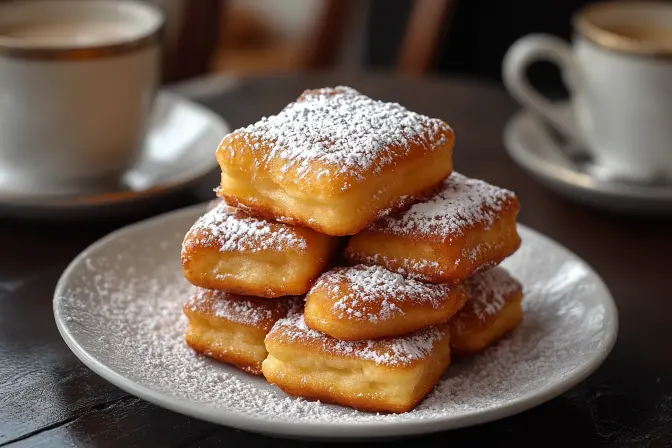Description
Indulge in the fluffy, melt-in-your-mouth experience of homemade Vanilla French Beignets! These delightful, square-shaped doughnuts, deeply rooted in New Orleans culinary tradition, are an absolute treat that can be enjoyed any time of day. Lightly fried to golden perfection and generously dusted with powdered sugar, they offer a warm, comforting sweetness that’s simply irresistible. This recipe brings the authentic taste of a French Quarter café right to your kitchen, making it easy to whip up a batch of these delectable treats whenever the craving strikes.
Why you will love this recipe
You will absolutely fall in love with this Vanilla French Beignet recipe for several reasons. Firstly, the flavor profile is exquisite – the delicate vanilla essence perfectly complements the slightly yeasty dough, creating a symphony of tastes that dance on your palate. Secondly, the recipe is surprisingly simple to follow, even for novice bakers. The step-by-step instructions ensure success, and the satisfaction of creating something so delicious from scratch is incredibly rewarding. Thirdly, these beignets are unbelievably versatile. Whether you’re serving them as a special breakfast treat, a sweet afternoon snack, or an elegant dessert after dinner, they are always a crowd-pleaser. Finally, the aroma that fills your kitchen while frying these beignets is simply intoxicating, creating a warm and inviting atmosphere that makes the entire baking experience truly special.
Ingredients:
- 2 ½ cups all-purpose flour
- ¼ cup granulated sugar
- 2 teaspoons active dry yeast
- ½ teaspoon salt
- 1 cup warm milk
- 1 tablespoon unsalted butter, melted
- 1 tablespoon pure vanilla extract
- Vegetable oil, for frying
- Powdered sugar, for dusting
Preparation:
Step 1: Prepare Dry Ingredients: In a large bowl, combine the 2 ½ cups of all-purpose flour, ¼ cup granulated sugar, 2 teaspoons active dry yeast, and ½ teaspoon salt. Ensure that the yeast is fresh for optimal rising. Mix well to distribute the yeast and sugar evenly through the flour. This even distribution is crucial for the yeast to properly activate and ensure a consistent rise in the dough. Sifting the flour beforehand can also help remove any lumps and create a lighter, airier beignet.
Step 2: Mix Wet Ingredients: In a separate bowl, whisk together 1 cup of warm milk (about 110°F), 1 tablespoon melted unsalted butter, and 1 tablespoon pure vanilla extract. The milk’s temperature is paramount; too hot, and it will kill the yeast; too cold, and the yeast won’t activate properly. Use a thermometer to ensure the milk is within the optimal temperature range. The melted butter adds richness and tenderness to the dough, while the pure vanilla extract provides a delightful aroma and flavor. Opt for high-quality vanilla extract for the best results.
Step 3: Combine Dry and Wet Ingredients: Gradually pour the wet ingredients into the dry ingredients while stirring with a wooden spoon until a dough begins to form. This gradual addition helps prevent clumping and ensures that the wet ingredients are evenly incorporated into the dry. Continue to mix until all ingredients are thoroughly combined. The dough will initially appear shaggy, but as you continue to mix, it will start to come together.
Step 4: Knead the Dough: Transfer the dough onto a lightly floured surface and knead for about 8-10 minutes until the dough is smooth and elastic. Kneading is essential for developing the gluten in the flour, which gives the beignets their characteristic chewiness. If the dough is too sticky, sprinkle a little more flour as needed, but be careful not to add too much, as this can result in a dense, tough beignet. The dough should be smooth and pliable, bouncing back slightly when you poke it.
Step 5: First Rise: Place the kneaded dough into a greased bowl, turning it once to coat all sides with oil. This prevents the dough from drying out during the rising process. Cover the bowl with a clean cloth or plastic wrap and let it rise in a warm, draft-free area for about 1.5 hours, or until it has doubled in size. A warm environment encourages the yeast to ferment and produce carbon dioxide, which causes the dough to rise. Ideal spots for rising include a preheated oven (turned off), a sunny windowsill, or a warm kitchen corner.
Step 6: Shape the Beignets: Once risen, gently punch down the dough to release the trapped air. This helps to even out the dough’s texture. Roll it out on a floured surface to about 1/4 inch thickness. Use a sharp knife or pizza cutter to cut the dough into 2×2 inch squares. The thickness of the dough is crucial; too thick, and the beignets will be doughy inside; too thin, and they will be crispy and lack the characteristic puffiness. Precise cutting ensures uniformity, allowing the beignets to cook evenly.
Step 7: Heat the Oil: Pour about 2 inches of vegetable oil into a deep fryer or large pot. Heat the oil to 360°F, using a candy or deep-fry thermometer to ensure accuracy. Maintaining the correct oil temperature is essential for achieving the perfect golden-brown color and ensuring that the beignets cook through evenly. Too low a temperature, and the beignets will absorb too much oil and become greasy; too high a temperature, and they will burn on the outside before cooking through on the inside.
Step 8: Fry the Beignets: Carefully fry the beignets in batches, being careful not to overcrowd the pot. Overcrowding the pot will lower the oil temperature and result in greasy beignets. Fry for about 1 to 2 minutes on each side, or until they are puffed up and golden brown. The beignets should float to the surface and puff up as they cook. Use a slotted spoon to remove them from the oil and drain on paper towels.
Step 9: Serve: Dust the freshly fried beignets generously with powdered sugar and serve immediately. The powdered sugar adds a touch of sweetness and elegance to the beignets. Serving them immediately ensures that they are at their freshest and most flavorful.
Step 10: Cooling: Allow the beignets to cool slightly on a wire rack if not served immediately. This helps to maintain their crispness and prevents them from becoming soggy.
COOKING Rating:
Easy to Medium
Serving Suggestions:
- Serve warm with a generous dusting of powdered sugar.
- Pair with a cup of strong coffee or chicory coffee for an authentic New Orleans experience.
- Serve with a side of fresh fruit or whipped cream for an extra touch of indulgence.
- Offer a variety of dipping sauces, such as chocolate sauce, caramel sauce, or raspberry jam.
- Make a beignet bar with different toppings and sauces for a fun and interactive dessert experience.
Tips:
- Ensure that your yeast is fresh for the best results.
- Use a thermometer to accurately measure the temperature of the warm milk and the frying oil.
- Don’t overcrowd the pot when frying the beignets to maintain the oil temperature.
- Dust the beignets with powdered sugar just before serving to prevent the sugar from melting.
- For a richer flavor, try adding a pinch of nutmeg or cinnamon to the dough.
- If you don’t have a deep fryer, a large, heavy-bottomed pot works just as well.
- Beignets are best enjoyed fresh, but they can be stored in an airtight container for up to 2 days. Reheat them slightly in the oven or microwave before serving.
Prep Time:
30 minutes
Cook Time:
15 minutes
Total Time:
2 hours (includes rising time)
Nutritional Information:
(Approximate values per beignet, without powdered sugar):
- Calories: 150
- Protein: 3g
- Sodium: 100mg
Conclusion
These Vanilla French Beignets are more than just a recipe; they are an experience. They transport you to the heart of New Orleans, where the aroma of freshly fried dough and the sweet taste of powdered sugar fill the air. This recipe is perfect for creating unforgettable moments with family and friends, whether it’s a special weekend breakfast or a delightful dessert after a long day. So, gather your ingredients, roll up your sleeves, and prepare to be amazed by the deliciousness you can create in your own kitchen. Enjoy!
Questions and Answers:
Q1: Can I use instant yeast instead of active dry yeast?
A: Yes, you can substitute instant yeast for active dry yeast in this recipe. The key difference is that instant yeast doesn’t require proofing. You can add it directly to the dry ingredients without dissolving it in warm water first. Use the same amount of instant yeast as the active dry yeast specified in the recipe (2 teaspoons). The rising time may be slightly shorter with instant yeast, so keep an eye on the dough and adjust accordingly.
Q2: What if my dough is too sticky to knead?
A: If your dough is too sticky, gradually add a little more flour, one tablespoon at a time, while kneading. Be careful not to add too much flour, as this can result in a dense, tough beignet. Continue kneading until the dough becomes smooth and elastic, but still slightly tacky. It should be easy to handle without sticking excessively to your hands or the work surface. Also, ensure your work surface is well-floured to prevent sticking.
Q3: Can I bake these beignets instead of frying them?
A: While these beignets are traditionally fried for their characteristic texture and flavor, you can attempt to bake them as a healthier alternative. However, the texture will be different, and they won’t be as light and airy. Preheat your oven to 375°F (190°C). Place the shaped beignets on a baking sheet lined with parchment paper. Brush them lightly with melted butter or oil. Bake for about 12-15 minutes, or until golden brown. Be aware that baked beignets will be denser and less puffy than fried ones.
Q4: How can I store leftover beignets?
A: Beignets are best enjoyed fresh, but if you have leftovers,




